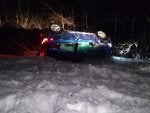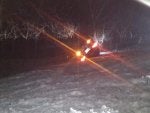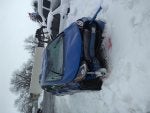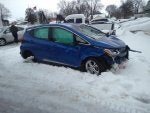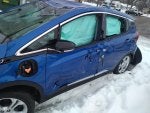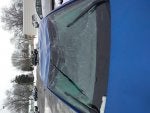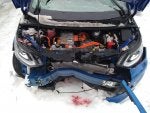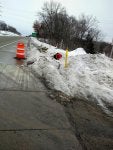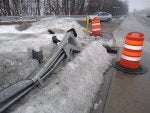This is the absolute worst way to get an extra charger. Definitely not recommended.
My son and I recently had an accident in the Bolt, which had only 8k miles and was only a tad over 3 months old. Well under the 300k miles I expected.
We are both not dead, and compared to dead, we are relatively ok, with no hospitalization, no broken bones, but still stiff and sore, both have concussions, etc. The healing process is very slow. Concussions, even mild ones, come with lots of collateral effects. It remains painful for me to sit almost two weeks later.
Here are the details, as I have been able to piece together. We squarely hit the start of a guardrail, likely at 65mph. The impact was nearly on center. The edge of the guardrail is narrow in width, but tall in height. It was nearly covered by snow. We went airborne for 46 feet, I believe landing on the rear of the car (Impact 2). We then dragged the outboard wheels only through the snow for another 30 feet to impact 3, where the car dug in, ejected the right rear wheel, and pivoted about 135 degrees. We then rolled to impact 4 and continued rolling to impact 5. Final resting position was on the roof, passenger side down. Total distance was 109 feet + 26 feet lateral from first impact.
The curtain airbags deployed. (Air bags have a smell, like gunpowder, and leave the cabin smoke filled, adding to the disorientation.) The front airbags did not deploy (seems wrong). The chair airbags did not deploy (apparently those are only when vehicle perimeter is impacted upon.) My glasses ended up not on my face with the lenses not in them, most likely blown off by the airbag
The vehicle remained locked, even after coming to rest and the airbags deploying [There's a needed firmware update to auto unlock plus shift to park.]
You can see how the A frames on both sides held up well, but you can also see how far the roof and windshield collapsed.
Being an engineer who's also curious, I'm having the forensic data pulled from the airbag module, along with any other modules we can get. I'll add that printout once I have it.
I feel that before airbags, this accident may not have been survivable. With gen 1 airbags, it likely would have been two ambulance rides. With the full, modern sensor suite, it was walk (or more accurately, limp) away. So, I'm thankful that I bought the best that Chevy had available, even while I'm disappointed that all the sensors didn't work properly.
It's also not clear how this accident would have been different with no snow. Then we would have struck the guard rail, and either stayed there (and needed to dissipate all the energy in one fell swoop), or we would have dissipated most of the energy and still ended up going up and over, rolling some, etc. Just like race cars, IndyCar in particular, are designed to shed parts/deform the car to help dissipate crash energy, the snow helped to spread out how energy was being dissipated into more distance and more time, but worse angles/directions. So, a summer crash would have been different, unclear if better or worse.
I believe that my front collision did NOT detect the guardrail. I know the system was working because it has alarmed on me while on other trips. I have previously estimated front detection will shed about 1/2 your speed and thus 3/4 of your momentum from when it kicks the cruise off (if you're in L) to the point of hitting another vehicle. So, we missed out on the protection from front detection. As you know, the lane keep can't even stay in a lane that is straight and that only will put an indicator in the mirror, so that was no real help either.
As I said, I'm getting data pulled. Hopefully, that will give some answers. Based on the pictures, my forensic engineer also thinks the front airbags should have been triggered.
Here's what I would like from the group:
1. Anyone who can show me exactly where the front airbag sensors are located.
2. Recommendations on what parts I should pull before I allow the car to be sent to the salvage yard.
3. Most importantly: Does anyone have contacts to inside the Chevy team on the Bolt, ideally to the airbag/frame group. I really feel like this crash found a design shortcoming and I want to try to get it addressed. If the front bags had gone off, my son would not have hit his head on the steering wheel. I think they're relying on that bar across the front to transfer the force into the frame, but it appears to be aluminum. Instead, mine shattered. I'm not trying to sue Chevy, just to get the Bolt improved.
4. Anybody who wants to outbid the salvage yard for the car is welcome. You'd get a nearly new battery pack to build yourself a powerwall. The car is in MN.
I really loved my Bolt. It's too bad that it's gone, but I'd much rather still have my son than my car.
My son and I recently had an accident in the Bolt, which had only 8k miles and was only a tad over 3 months old. Well under the 300k miles I expected.
We are both not dead, and compared to dead, we are relatively ok, with no hospitalization, no broken bones, but still stiff and sore, both have concussions, etc. The healing process is very slow. Concussions, even mild ones, come with lots of collateral effects. It remains painful for me to sit almost two weeks later.
Here are the details, as I have been able to piece together. We squarely hit the start of a guardrail, likely at 65mph. The impact was nearly on center. The edge of the guardrail is narrow in width, but tall in height. It was nearly covered by snow. We went airborne for 46 feet, I believe landing on the rear of the car (Impact 2). We then dragged the outboard wheels only through the snow for another 30 feet to impact 3, where the car dug in, ejected the right rear wheel, and pivoted about 135 degrees. We then rolled to impact 4 and continued rolling to impact 5. Final resting position was on the roof, passenger side down. Total distance was 109 feet + 26 feet lateral from first impact.
The curtain airbags deployed. (Air bags have a smell, like gunpowder, and leave the cabin smoke filled, adding to the disorientation.) The front airbags did not deploy (seems wrong). The chair airbags did not deploy (apparently those are only when vehicle perimeter is impacted upon.) My glasses ended up not on my face with the lenses not in them, most likely blown off by the airbag
The vehicle remained locked, even after coming to rest and the airbags deploying [There's a needed firmware update to auto unlock plus shift to park.]
You can see how the A frames on both sides held up well, but you can also see how far the roof and windshield collapsed.
Being an engineer who's also curious, I'm having the forensic data pulled from the airbag module, along with any other modules we can get. I'll add that printout once I have it.
I feel that before airbags, this accident may not have been survivable. With gen 1 airbags, it likely would have been two ambulance rides. With the full, modern sensor suite, it was walk (or more accurately, limp) away. So, I'm thankful that I bought the best that Chevy had available, even while I'm disappointed that all the sensors didn't work properly.
It's also not clear how this accident would have been different with no snow. Then we would have struck the guard rail, and either stayed there (and needed to dissipate all the energy in one fell swoop), or we would have dissipated most of the energy and still ended up going up and over, rolling some, etc. Just like race cars, IndyCar in particular, are designed to shed parts/deform the car to help dissipate crash energy, the snow helped to spread out how energy was being dissipated into more distance and more time, but worse angles/directions. So, a summer crash would have been different, unclear if better or worse.
I believe that my front collision did NOT detect the guardrail. I know the system was working because it has alarmed on me while on other trips. I have previously estimated front detection will shed about 1/2 your speed and thus 3/4 of your momentum from when it kicks the cruise off (if you're in L) to the point of hitting another vehicle. So, we missed out on the protection from front detection. As you know, the lane keep can't even stay in a lane that is straight and that only will put an indicator in the mirror, so that was no real help either.
As I said, I'm getting data pulled. Hopefully, that will give some answers. Based on the pictures, my forensic engineer also thinks the front airbags should have been triggered.
Here's what I would like from the group:
1. Anyone who can show me exactly where the front airbag sensors are located.
2. Recommendations on what parts I should pull before I allow the car to be sent to the salvage yard.
3. Most importantly: Does anyone have contacts to inside the Chevy team on the Bolt, ideally to the airbag/frame group. I really feel like this crash found a design shortcoming and I want to try to get it addressed. If the front bags had gone off, my son would not have hit his head on the steering wheel. I think they're relying on that bar across the front to transfer the force into the frame, but it appears to be aluminum. Instead, mine shattered. I'm not trying to sue Chevy, just to get the Bolt improved.
4. Anybody who wants to outbid the salvage yard for the car is welcome. You'd get a nearly new battery pack to build yourself a powerwall. The car is in MN.
I really loved my Bolt. It's too bad that it's gone, but I'd much rather still have my son than my car.


